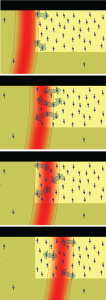With tin sometimes described as one of the base (think homeliest) metals, perhaps it should come as no surprise that it, like the misidentified cygnet in Hans Christian Andersen’s tale The Ugly Duckling, may actually be inherently beautiful — at least in the eyes of those who appreciate the potential of thermoelectricity.
To draw the analogy, Professor Joseph Heremans, borrowed the title “Thermoelectricity: The ugly duckling” for an article that he authored and which appears in the April 17, 2014 print edition (Volume 508) of the journal Nature. The article, which can be found on pages 327-328 in the News and Views section of the journal, details why there’s beauty (or higher than imagined thermoelectric efficiency) in the single crystals of tin selenide. The article also serves as context for a research paper authored by a group Northwestern University researchers whom belong to the same Energy Frontier Research Center as Professor Heremans and his research team. According to Heremans, the study led by Professor Mercouri Kanatzidis at Northwestern University, his graduate student Li-Dong Zhao and colleagues further underscores the fact that progress in the thermal sciences relative to thermoelectric power applications has been unrelenting and discoveries about thermal conductivity often quite surprising.

